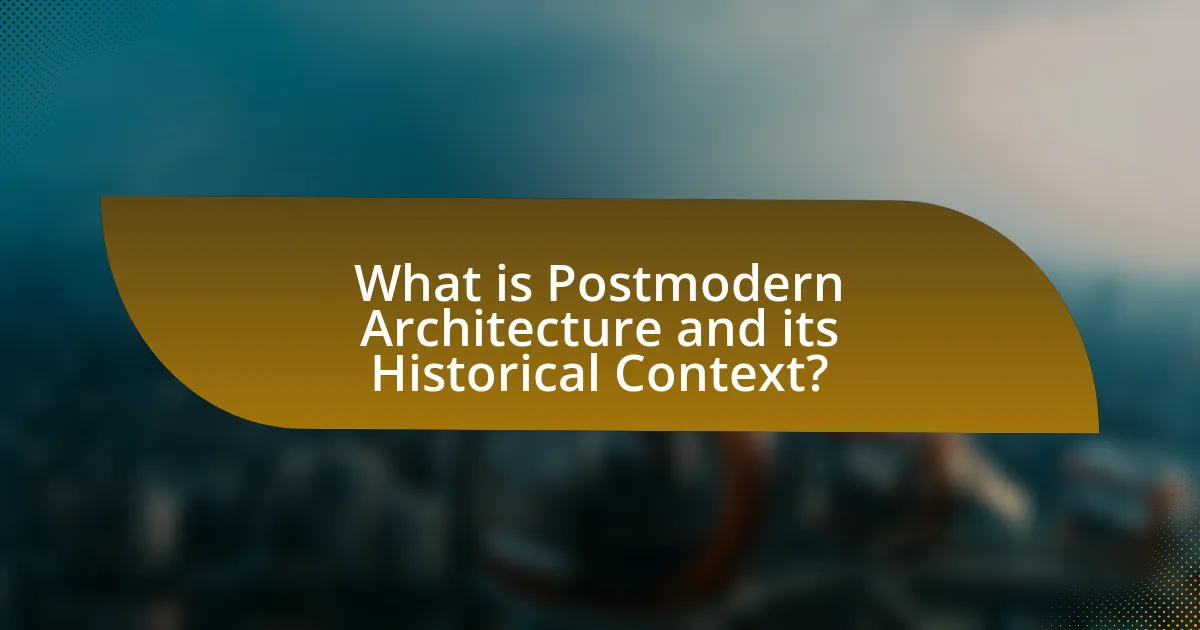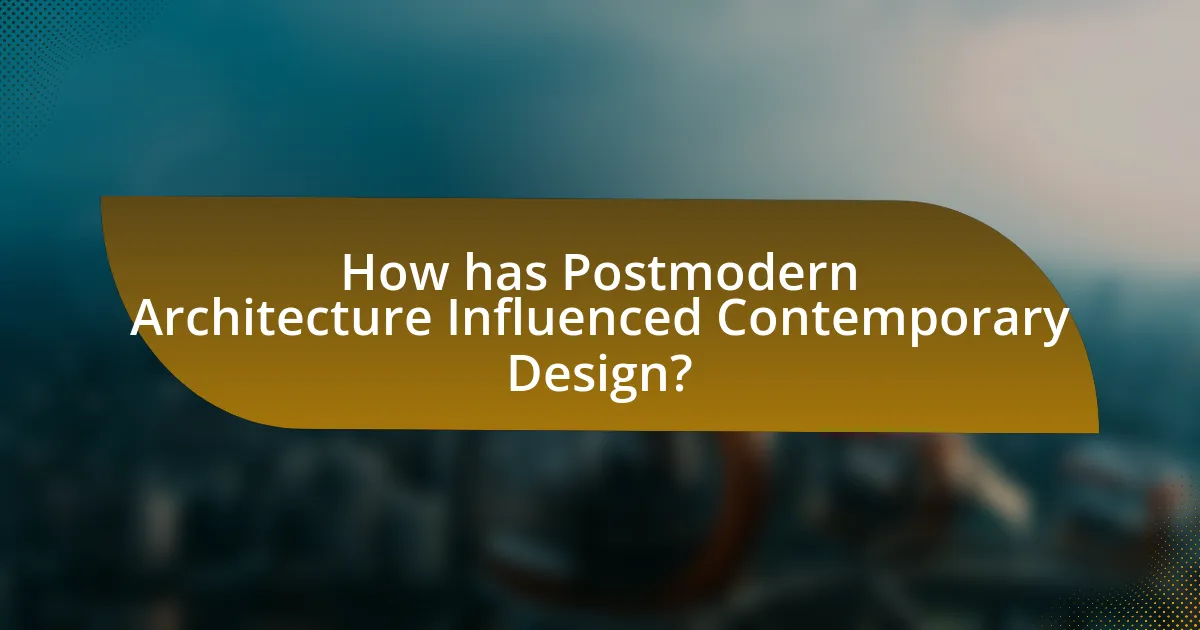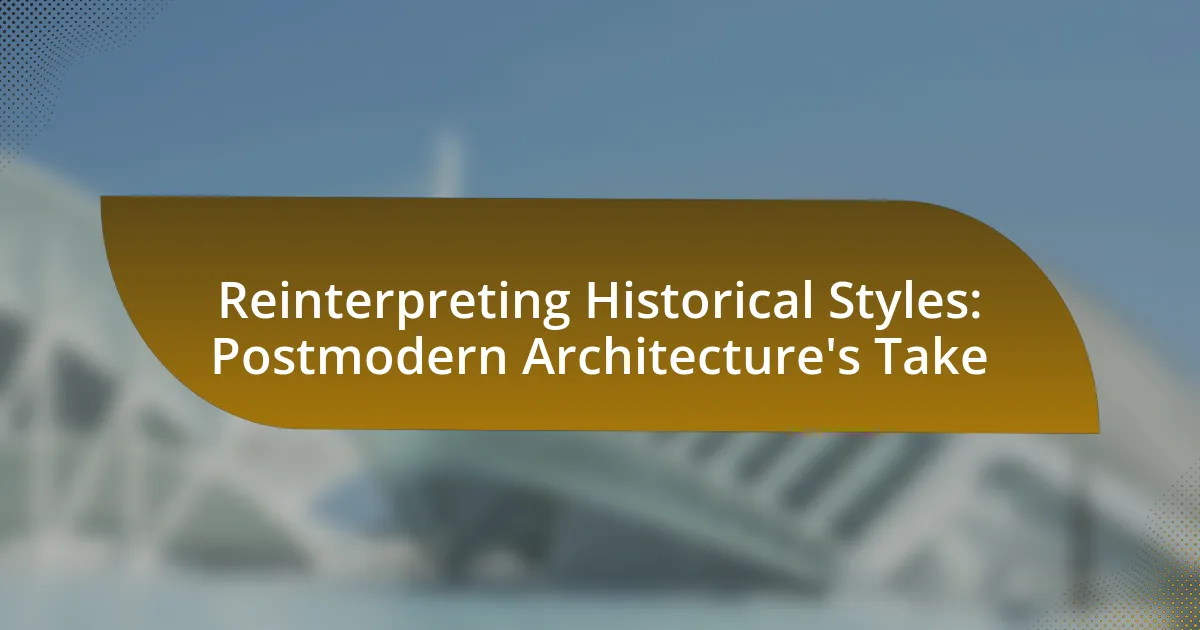Postmodern architecture is a movement that emerged in the late 20th century, characterized by its departure from modernism and its embrace of eclecticism, ornamentation, and historical references. This architectural style arose as a reaction against the minimalist and functionalist principles of modernism, emphasizing complexity and cultural significance. Key figures such as Robert Venturi and Michael Graves played pivotal roles in this movement, creating notable works like the Portland Building and the Vanna Venturi House, which showcase playful forms and a mix of styles. The article explores the historical context of postmodern architecture, its key characteristics, the reinterpretation of historical styles, and the influence it has had on contemporary design, while also addressing criticisms and challenges associated with the movement.

What is Postmodern Architecture and its Historical Context?
Postmodern architecture is a movement that emerged in the late 20th century, characterized by a departure from the principles of modernism, emphasizing eclecticism, ornamentation, and historical references. This architectural style arose in the 1960s and 1970s as a reaction against the minimalist and functionalist approaches of modernism, which often prioritized form over context and cultural significance.
Historically, postmodern architecture reflects the broader cultural shifts of the post-World War II era, including the rise of consumerism, globalization, and a questioning of established narratives. Key figures such as Robert Venturi and Michael Graves advocated for a more inclusive approach to design, incorporating elements from various historical styles and popular culture. Notable examples include the Portland Building (1982) by Graves and the Vanna Venturi House (1964) by Venturi, which showcase playful forms and a mix of styles that challenge traditional architectural norms.
How did Postmodern Architecture emerge as a response to Modernism?
Postmodern Architecture emerged as a response to Modernism by rejecting its principles of minimalism, functionalism, and the idea that “form follows function.” This architectural movement, which gained prominence in the late 20th century, sought to embrace complexity, ornamentation, and historical references, contrasting sharply with the austere and often impersonal designs characteristic of Modernism. Notably, architects like Robert Venturi and Michael Graves incorporated eclectic styles and playful elements, emphasizing the importance of context and cultural symbolism in their designs. The shift was also a reaction to the perceived failures of Modernism to address social and environmental concerns, leading to a more inclusive and diverse approach to architecture that celebrated individuality and historical richness.
What key characteristics define Postmodern Architecture?
Postmodern architecture is characterized by its eclecticism, irony, and a departure from the strict forms of modernism. This architectural style often incorporates historical references, playful elements, and a mix of different styles and materials, reflecting a rejection of the minimalist and functionalist principles of modernism. For example, buildings like the Portland Building by Michael Graves showcase decorative elements and a variety of colors, which contrast sharply with the austere designs of modernist architecture. Additionally, postmodern architecture emphasizes context and the relationship between the building and its surroundings, often using symbolism and cultural references to engage with the viewer.
How does Postmodern Architecture reinterpret historical styles?
Postmodern architecture reinterprets historical styles by blending diverse elements from various architectural traditions, often incorporating irony and eclecticism. This approach allows architects to challenge the rigid principles of modernism, embracing ornamentation and historical references that were previously dismissed. For instance, buildings like the Portland Building by Michael Graves utilize classical motifs and playful forms, demonstrating a departure from the minimalist aesthetic of modernism. Additionally, postmodern architecture often employs pastiche, combining different styles to create a new narrative, as seen in the Piazza d’Italia in New Orleans, which merges classical and contemporary elements. This reinterpretation reflects a broader cultural shift towards pluralism and complexity in design.
Why is the study of historical styles important in Postmodern Architecture?
The study of historical styles is important in Postmodern Architecture because it allows architects to draw inspiration from diverse design elements and cultural contexts. By analyzing past architectural movements, Postmodern architects can reinterpret and blend various styles, creating buildings that reflect a multiplicity of influences rather than a singular narrative. This approach is evident in the works of architects like Robert Venturi and Michael Graves, who incorporated historical references and ornamentation to challenge the minimalist principles of Modernism. Such reinterpretation fosters a dialogue between the past and present, enriching the architectural landscape and enhancing cultural significance.
What historical styles are most commonly referenced in Postmodern designs?
Postmodern designs commonly reference historical styles such as Classical, Baroque, and Art Deco. These styles are integrated into Postmodern architecture to create a dialogue between the past and present, often characterized by eclecticism and irony. For instance, the use of Classical columns in a playful manner or the incorporation of Baroque ornamentation reflects a departure from the minimalist principles of Modernism, showcasing a revival of decorative elements. This blending of styles is evident in notable Postmodern buildings like the Portland Building by Michael Graves, which features a façade that combines various historical references, illustrating the movement’s embrace of complexity and contradiction.
How do cultural contexts influence the reinterpretation of historical styles?
Cultural contexts significantly influence the reinterpretation of historical styles by shaping the values, aesthetics, and meanings attributed to those styles. For instance, postmodern architecture often draws from historical styles but reinterprets them to reflect contemporary societal values, such as diversity and pluralism. This is evident in the use of eclectic design elements that combine various historical references, allowing architects to challenge traditional narratives and create spaces that resonate with modern audiences. The incorporation of local materials and cultural symbols further illustrates how cultural contexts inform these reinterpretations, as seen in buildings that blend global architectural influences with regional characteristics, thereby creating a dialogue between the past and present.

What are the Key Features of Postmodern Architecture?
The key features of postmodern architecture include eclecticism, irony, and a playful approach to historical references. Eclecticism allows architects to blend various styles and elements from different periods, creating unique and diverse structures. Irony is often expressed through unexpected forms and materials, challenging traditional architectural norms. Additionally, postmodern architecture frequently incorporates decorative elements and symbolism, emphasizing aesthetics over functionality. This movement emerged in the late 20th century as a reaction against the minimalism and uniformity of modernism, with notable examples including the Portland Building by Michael Graves and the Piazza d’Italia in New Orleans, showcasing these characteristics.
How does Postmodern Architecture differ from its predecessors?
Postmodern architecture differs from its predecessors by rejecting the strict functionalism and minimalism of modernism, embracing eclecticism, ornamentation, and historical references. While modernist architecture prioritized simplicity and the idea that form follows function, postmodern architecture incorporates diverse styles, playful forms, and a mix of materials, often drawing inspiration from historical architectural elements. This shift is evident in buildings like the Portland Building by Michael Graves, which features decorative elements and a vibrant color palette, contrasting sharply with the austere designs of modernist icons such as Le Corbusier.
What role does eclecticism play in Postmodern design?
Eclecticism plays a central role in Postmodern design by allowing the integration of diverse historical styles and cultural references into a cohesive aesthetic. This approach enables designers to break away from the rigid constraints of modernism, embracing a mix of elements from various periods and movements, such as classical, baroque, and contemporary influences. For instance, architects like Robert Venturi and Michael Graves utilized eclecticism to create buildings that juxtapose different styles, reflecting a pluralistic view of architecture that celebrates complexity and contradiction. This blending of styles not only enriches the visual language of Postmodern design but also fosters a dialogue between the past and present, making architecture more relatable and accessible to a broader audience.
How do ornamentation and symbolism manifest in Postmodern structures?
Ornamentation and symbolism in Postmodern structures manifest through eclectic design elements and historical references that challenge modernist minimalism. Postmodern architecture often incorporates decorative features, such as vibrant colors, varied materials, and playful forms, which serve to evoke cultural narratives and personal expression. For example, buildings like the Portland Building by Michael Graves utilize classical motifs and exaggerated forms to create a dialogue with historical architecture, thereby infusing contemporary structures with layers of meaning. This approach reflects a broader trend in Postmodernism, where architects intentionally blend styles and symbols to create a sense of place and identity, as seen in the work of Robert Venturi, who famously stated that “less is a bore,” advocating for a richer visual language.
What are some notable examples of Postmodern Architecture?
Notable examples of Postmodern Architecture include the Portland Building in Oregon, designed by Michael Graves, and the Piazza d’Italia in New Orleans, created by Charles Moore. The Portland Building, completed in 1982, is recognized for its colorful façade and playful use of classical elements, which challenge modernist principles. The Piazza d’Italia, completed in 1978, features a vibrant public space that incorporates classical motifs and contemporary materials, reflecting a blend of historical references and modern design. These structures exemplify the Postmodern approach of reinterpreting historical styles while emphasizing context and cultural significance.
Which buildings exemplify the reinterpretation of historical styles?
The Guggenheim Museum Bilbao exemplifies the reinterpretation of historical styles through its innovative design by Frank Gehry, which combines organic forms with traditional architectural elements. This building, completed in 1997, integrates modern materials and techniques while referencing historical styles, particularly through its use of curvilinear shapes that evoke the fluidity of classical architecture. Another notable example is the Portland Building in Oregon, designed by Michael Graves in 1982, which incorporates postmodern elements and classical motifs, such as the use of vibrant colors and decorative features that challenge the minimalist trends of modernism. These buildings illustrate how contemporary architects draw inspiration from historical styles while creating unique, modern expressions.
How do these examples reflect the principles of Postmodernism?
The examples reflect the principles of Postmodernism by showcasing a deliberate departure from modernist ideals, emphasizing eclecticism, irony, and historical reference. Postmodern architecture often incorporates diverse styles and elements from various historical periods, as seen in buildings that blend classical motifs with contemporary materials, creating a dialogue between past and present. This approach challenges the notion of a singular architectural narrative, instead celebrating pluralism and subjective interpretation, which are core tenets of Postmodernism. For instance, the Portland Building by Michael Graves exemplifies this by merging traditional forms with playful colors and ornamentation, illustrating how Postmodernism embraces complexity and contradiction in design.

How has Postmodern Architecture Influenced Contemporary Design?
Postmodern architecture has significantly influenced contemporary design by promoting eclecticism and a playful approach to form and materials. This movement, which emerged in the late 20th century, challenged the minimalist and functionalist principles of modernism, encouraging designers to incorporate historical references, ornamentation, and diverse styles. For instance, the use of bold colors, varied textures, and unconventional shapes in contemporary buildings can be traced back to postmodernist ideals, as seen in structures like the Guggenheim Museum Bilbao by Frank Gehry, which exemplifies the integration of artistic expression with architectural form. Additionally, the emphasis on context and narrative in design, a hallmark of postmodernism, continues to shape contemporary architecture, fostering a dialogue between new constructions and their surroundings.
What impact has Postmodernism had on current architectural trends?
Postmodernism has significantly influenced current architectural trends by promoting eclecticism and a departure from the minimalist principles of Modernism. This movement encourages the integration of historical references, ornamentation, and diverse styles, allowing architects to create buildings that resonate with cultural narratives and local contexts. For instance, the use of playful forms and vibrant colors in contemporary architecture reflects Postmodernism’s challenge to uniformity, as seen in projects like the Portland Building by Michael Graves, which incorporates classical elements in a modern context. This blending of styles has led to a more inclusive architectural language that values individual expression and contextual relevance, shaping the way architects approach design today.
How do contemporary architects incorporate historical references in their work?
Contemporary architects incorporate historical references in their work by blending traditional design elements with modern techniques and materials. This approach often involves reinterpreting classical styles, such as using columns, arches, and ornamentation in innovative ways that resonate with current aesthetics and functionality. For example, architects like Robert Venturi and Frank Gehry have utilized historical motifs to create dialogue between the past and present, demonstrating that historical references can enhance contemporary architecture’s narrative and cultural significance. This practice not only honors architectural heritage but also allows for a richer, more layered understanding of space and form in modern contexts.
What lessons can be learned from Postmodern Architecture for future designs?
Postmodern architecture teaches that embracing eclecticism and historical references can enrich future designs. This approach encourages architects to draw inspiration from various styles and periods, allowing for a more diverse and culturally resonant built environment. For instance, the use of ornamentation and playful forms in postmodern buildings, such as the Portland Building by Michael Graves, demonstrates how integrating historical elements can create visually engaging structures that resonate with the public. Additionally, postmodernism emphasizes the importance of context and community, suggesting that future designs should prioritize local culture and user experience, as seen in the work of architects like Robert Venturi, who advocated for a more inclusive and accessible architectural language.
What are the challenges and criticisms of Postmodern Architecture?
Postmodern architecture faces several challenges and criticisms, primarily centered around its perceived lack of coherence and depth. Critics argue that postmodern buildings often prioritize aesthetics over functionality, leading to structures that may appear superficial or gimmicky. For instance, the use of eclectic styles and historical references can result in a disjointed visual language that lacks a unified architectural identity. Additionally, some detractors claim that postmodernism’s embrace of irony and playfulness can undermine the seriousness of architectural discourse, making it difficult to address pressing social and environmental issues. Furthermore, the movement has been criticized for its commercialism, as many postmodern designs cater to market trends rather than community needs, which can lead to a disconnect between architecture and the public it serves.
How do critics view the use of historical styles in Postmodern design?
Critics view the use of historical styles in Postmodern design as a complex interplay of irony and pastiche. They argue that Postmodernism often employs historical references not to celebrate them, but to critique modernist ideals of originality and authenticity. For instance, architectural theorist Charles Jencks posits that Postmodern architecture embraces eclecticism, allowing for a playful combination of styles that challenges the notion of a singular architectural narrative. This perspective is supported by examples such as the Piazza d’Italia in New Orleans, which juxtaposes classical elements with contemporary forms, illustrating how historical styles can be reinterpreted to create new meanings.
What are the implications of Postmodernism on architectural authenticity?
Postmodernism significantly challenges the concept of architectural authenticity by promoting eclecticism and the mixing of styles. This movement, which emerged in the late 20th century, often embraces historical references and pastiche, leading to structures that may prioritize aesthetic appeal over historical accuracy. For instance, buildings designed in a Postmodern style frequently incorporate elements from various architectural traditions, creating a sense of irony and playfulness that can dilute the original context and meaning of those styles. The implications of this approach suggest that authenticity becomes subjective, as the value of a building may lie more in its visual impact and cultural commentary than in its fidelity to historical precedents.
What practical insights can be gained from studying Postmodern Architecture?
Studying Postmodern Architecture provides practical insights into the integration of historical styles with contemporary design, emphasizing diversity and contextuality in architectural practice. This architectural movement, which emerged in the late 20th century, encourages architects to draw inspiration from various historical references while also addressing the specific cultural and social contexts of their projects. For instance, the use of eclectic forms and ornamentation in Postmodern buildings, such as the Portland Building designed by Michael Graves, illustrates how blending different styles can create unique and meaningful spaces. Additionally, Postmodern Architecture highlights the importance of user experience and community engagement, as seen in projects that prioritize public interaction and accessibility, thereby influencing modern architectural approaches.
How can architects effectively blend historical styles in modern projects?
Architects can effectively blend historical styles in modern projects by employing a contextual approach that respects the original architectural elements while integrating contemporary design principles. This involves analyzing the historical context, materials, and forms of the styles being referenced, and then reinterpreting them through modern techniques and technologies. For instance, the use of modern materials like glass and steel can complement traditional brick or stone, creating a dialogue between old and new. Additionally, architects can draw inspiration from historical proportions and ornamentation, adapting them to fit modern aesthetics and functionality. This method has been successfully demonstrated in projects like the Louvre Pyramid in Paris, where I.M. Pei combined modern glass with the classical architecture of the Louvre, creating a harmonious blend that respects the historical significance while providing a contemporary twist.
What best practices should be followed when interpreting historical influences?
When interpreting historical influences, it is essential to contextualize the influences within their specific cultural, social, and political environments. This practice ensures a comprehensive understanding of how historical events and movements shaped architectural styles. For instance, examining the impact of the Industrial Revolution on Victorian architecture reveals how technological advancements influenced design choices, such as the use of iron and glass. Additionally, analyzing primary sources, such as architectural critiques and contemporaneous writings, provides insights into the intentions and perceptions of architects during that period. This method reinforces accuracy by grounding interpretations in factual evidence, allowing for a nuanced appreciation of historical influences on postmodern architecture.
